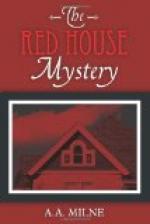Fortunately (from Mark’s point of view) his patron died during his third year in London, and left him all the money he wanted. From that moment his life loses its legendary character, and becomes more a matter of history. He settled accounts with the money-lenders, abandoned his crop of wild oats to the harvesting of others, and became in his turn a patron. He patronized the Arts. It was not only usurers who discovered that Mark Ablett no longer wrote for money; editors were now offered free contributions as well as free lunches; publishers were given agreements for an occasional slender volume, in which the author paid all expenses and waived all royalties; promising young painters and poets dined with him; and he even took a theatrical company on tour, playing host and “lead” with equal lavishness.
He was not what most people call a snob. A snob has been defined carelessly as a man who loves a lord; and, more carefully, as a mean lover of mean things—which would be a little unkind to the peerage if the first definition were true. Mark had his vanities undoubtedly, but he would sooner have met an actor-manager than an earl; he would have spoken of his friendship with Dante—had that been possible—more glibly than of his friendship with the Duke. Call him a snob if you like, but not the worst kind of snob; a hanger-on, but to the skirts of Art, not Society; a climber, but in the neighbourhood of Parnassus, not Hay Hill.
His patronage did not stop at the Arts. It also included Matthew Cayley, a small cousin of thirteen, whose circumstances were as limited as had been Mark’s own before his patron had rescued him. He sent the Cayley cousin to school and Cambridge. His motives, no doubt, were unworldly enough at first; a mere repaying to his account in the Recording Angel’s book of the generosity which had been lavished on himself; a laying-up of treasure in heaven. But it is probable that, as the boy grew up, Mark’s designs for his future were based on his own interests as much as those of his cousin, and that a suitably educated Matthew Cayley of twenty-three was felt by him to be a useful property for a man in his position; a man, that is to say, whose vanities left him so little time for his affairs.




